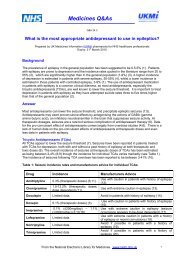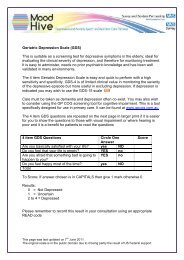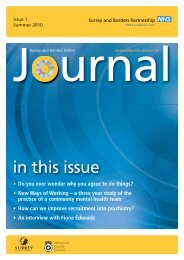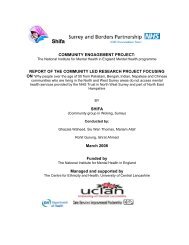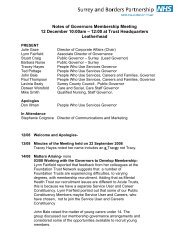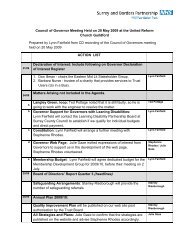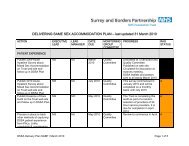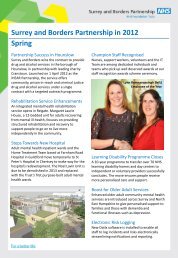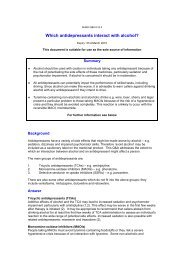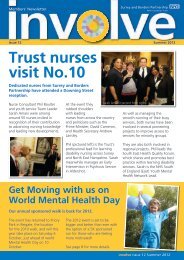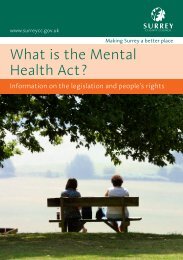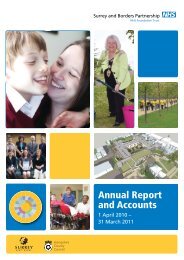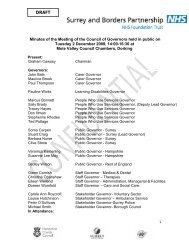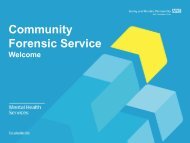DVLA "at a glance" fitness to drive - Heart Rhythm UK
DVLA "at a glance" fitness to drive - Heart Rhythm UK
DVLA "at a glance" fitness to drive - Heart Rhythm UK
You also want an ePaper? Increase the reach of your titles
YUMPU automatically turns print PDFs into web optimized ePapers that Google loves.
-The applicant or licence holder must notify <strong>DVLA</strong> unless st<strong>at</strong>ed otherwise in the text<br />
Appendix 1<br />
DISABLED DRIVERS<br />
CARS (Group 1)<br />
Driving is possible in both st<strong>at</strong>ic and progressive or relapsing disorders but vehicle modific<strong>at</strong>ion may be needed.<br />
1) Permanent Limb Disabilities/ e.g. Amput<strong>at</strong>ion, Hemiplegia/Cerebral Palsy, Ankylosing Spondylitis,<br />
Spinal Disabilities<br />
Severe Arthritis, especially with pain<br />
2) Chronic Neurological Disorders: e.g. Multiple Sclerosis, Parkinson’s Disease,<br />
Mo<strong>to</strong>r Neurone Disease, peripheral neurop<strong>at</strong>hy<br />
Sophistic<strong>at</strong>ed vehicle adapt<strong>at</strong>ion is now possible and varies from au<strong>to</strong>m<strong>at</strong>ic transmission <strong>to</strong> joy sticks and infra red<br />
controls for people with severe disabilities.<br />
The <strong>DVLA</strong> will need <strong>to</strong> know which, if any, of the controls require <strong>to</strong> be modified and will ask the p<strong>at</strong>ient <strong>to</strong> complete a<br />
simple questionnaire. The driving licence will then be coded <strong>to</strong> reflect the modific<strong>at</strong>ions. A list of assessment centres is<br />
available <strong>at</strong> appendix 2 on page 42, which will be able <strong>to</strong> give advice should the licence holder require it.<br />
NB: A person in receipt of the higher r<strong>at</strong>e mobility component of the Disability Living Allowance may hold a<br />
driving licence from 16 years of age.<br />
LGV/PCV (Group 2)<br />
Some disabilities may be comp<strong>at</strong>ible with the driving of large vehicles if mild and non-progressive. Individual<br />
assessment will be required.<br />
ELECTRICALLY PROPELLED INVALID CARRIAGES (CLASS 2 & 3)<br />
Class 2 vehicles are limited <strong>to</strong> 4 miles per hour and Class 3 vehicles <strong>to</strong> 8 miles per hour whilst on the road.<br />
Users of these vehicles are not required <strong>to</strong> hold a driving licence and so are not required <strong>to</strong> meet the medical standards<br />
required of <strong>drive</strong>rs of mo<strong>to</strong>r vehicles. However, individuals whose medical condition may affect their ability <strong>to</strong> <strong>drive</strong><br />
an invalid carriage safely are advised <strong>to</strong> consult their GP before using these vehicles. We also recommend th<strong>at</strong> the<br />
user is able <strong>to</strong> read a car number pl<strong>at</strong>e from a distance of 12.3 metres (40 ft). For further details please refer <strong>to</strong> the<br />
public<strong>at</strong>ion “Code of Practice for Class 3 Vehicle Users” available from the Mobility & Inclusion Unit, Department<br />
for Transport, Gre<strong>at</strong> Minster House, 76 Marsham Street, London SW1P 4DR; Tel: 0207 944 4461; Fax: 0207 944<br />
6102; Email: miu@dft.gsi.gov.uk<br />
44



